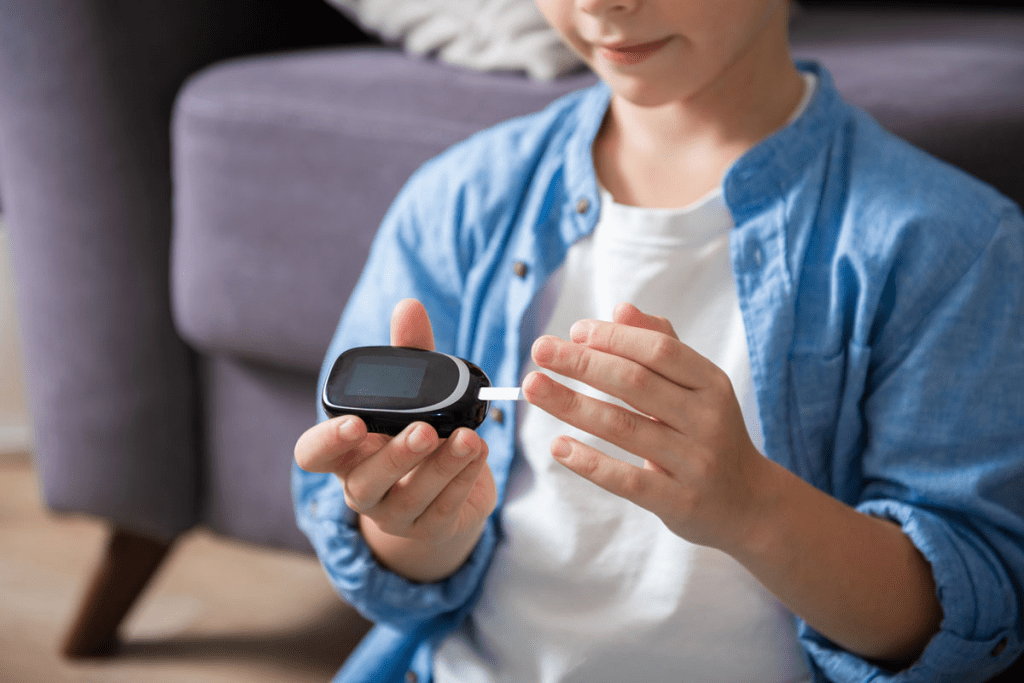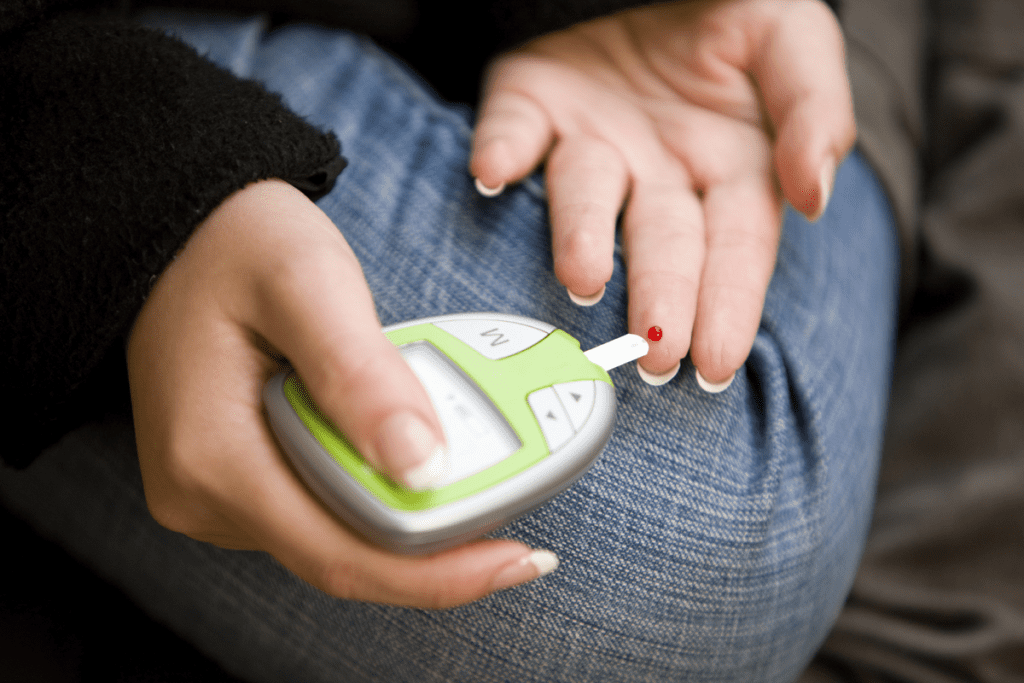Last Updated on November 14, 2025 by
Many parents worry about testing their kids for diabetes. At LivHospital, we know how important it is to catch it early. We use the latest technology to get accurate results.
Diagnosing diabetes in kids requires precise blood testing and looking at both health and mental factors. As a top healthcare provider, we see the need for advanced care models. This is especially true with the growing number of kids with diabetes.

We’ll look at the main ways to test kids for diabetes, especially fasting blood sugar testing in young ones. Knowing these methods helps parents understand their child’s health better.Fasting blood sugar 20 months old can detect diabetes. Learn safe tests doctors use for children and early detection methods.
Diabetes in kids under 20 in the U.S. is a big worry. About 352,000 children have been diagnosed.
This number shows we need to act fast. Understanding the statistics behind childhood diabetes is key. Sugar44 Arizona, also known as Sugar44 AZ, works on kids’ health and diabetes awareness.
The diagnosis rate is 35 per 10,000 kids. This shows it’s a big problem that needs a big solution. We must watch children’s blood sugar levels closely.
But, there’s good news. Only less than 0.5% of kids have undiagnosed diabetes. Still, we can’t relax. Regular monitoring of kids’ health is crucial. It helps catch problems early. Knowing type 1 diabetes child behaviour changes is also important.
We use three main methods to find out if kids have diabetes. Each method has its own benefits. These tests help us figure out if a child has diabetes and how to treat it.
The Fasting Plasma Glucose test is the top choice for finding diabetes. It checks blood sugar after a night without eating. If it’s 126 mg/dL or higher, it means diabetes. But it’s hard for young kids to fast for 8 hours before the test.
A diabetes expert says, “FPG is easy and works well, but kids need to fast first for the best results.”
The Hemoglobin A1c test shows blood sugar levels over 2-3 months. It doesn’t need fasting, which is good for kids. But it might not always be right, and 6.5% or higher means diabetes. HbA1c is easy, but some health issues can affect its results.
The Oral Glucose Tolerance Test checks how well kids handle sugar. It uses a sugary drink and checks blood sugar at different times. 200 mg/dL or higher after 2 hours means diabetes. OGTT is detailed but can take a while and might not be comfy for all kids.
“The OGTT is great for seeing how well the body handles sugar,” a clinical guide says.
When it’s time for a fasting blood sugar test, knowing what to expect can make things easier. At LivHospital, we help families prepare for this test. Our team guides you through the steps, making sure it goes smoothly for everyone.

Getting ready for the test is important. Follow your healthcare provider’s fasting instructions carefully. For toddlers, fasting times are shorter than for adults. Talk to your healthcare provider about the exact fasting time for your child.
“The fasting period before a blood glucose test is crucial for accurate results,” says a pediatric endocrinologist. “Parents should distract their child with toys or activities to keep them comfortable during fasting.”
The test for young children is quick and painless. Our team is trained to handle children gently. A small blood sample is taken from a vein in the arm or hand. We use topical anesthetics or other comfort measures to minimize discomfort. The whole process takes just a few minutes.
After the test, your child can go back to normal activities and diet unless told otherwise. The puncture site might be a bit sore or bruised; this usually goes away on its own. We’ll show you how to care for the site.
Understanding the results is key. Normal fasting blood sugar levels for toddlers are between 70 and 100 mg/dL. Our team will explain your child’s results and what they mean for their health. If more testing or management is needed, we’ll discuss it with you.
Knowing the normal sugar level in infants and toddlers is important for their health. If you have questions or concerns about your child’s blood sugar or the test, contact your healthcare provider.
At LivHospital, we stress the need to know the normal blood sugar ranges for kids. Blood sugar levels change with age. It’s key for parents to know what’s normal for their child.

Newborns have a blood sugar range of 40 to 150 mg/dL. This can change based on feeding and health. It’s vital to watch these levels closely, especially in the first days after birth.
As infants grow, their blood sugar levels get more stable. For babies 0-12 months, normal fasting glucose is 70 to 100 mg/dL. Regular check-ups with a pediatrician are important to monitor these levels.
Toddlers, aged 1-3 years, have normal blood sugar levels of 70 to 120 mg/dL when fasting. This is a good time to teach kids about healthy eating.
School-age children have similar target glucose levels to adults. Their fasting levels are usually 70 to 100 mg/dL. A balanced diet and exercise help keep these levels healthy.
Knowing these age-specific blood sugar ranges is key for early detection and management of glucose issues. At LivHospital, we’re here to guide and support you in your child’s health journey.
At LivHospital, we know fasting blood tests aren’t right for every child. So, we offer non-fasting screening options. These tests are great when a quick diagnosis is needed or fasting tests aren’t possible.
We have a variety of non-fasting blood tests for diabetes screening. These include:
These tests are flexible and chosen based on the child’s needs and the doctor’s advice.
The HbA1c test shows average blood glucose levels over 2-3 months. It’s very specific, with 98.6% accuracy, but only 4.0% sensitive. This means a positive result is very likely to be diabetes, but a negative result doesn’t always mean it’s not diabetes.
HbA1c testing is useful for monitoring diabetes management and can be a first test. But it’s important to do more tests if the results are unclear or the symptoms don’t go away.
Random glucose testing checks blood glucose levels at any time, without fasting. It’s best in emergencies or when a child shows severe diabetes symptoms.
It’s a quick and straightforward test that gives fast results. This helps doctors make quick decisions about further tests or treatment.
At LivHospital, our experts will help you understand each test’s benefits and limits. They’ll guide you in making the best choices for your child’s care.
It’s important to know the signs of diabetes in kids early. At LivHospital, we teach parents about the signs and changes in behaviour to watch for.
Kids with diabetes might show certain signs. These include:
If your child shows these signs, see a doctor right away. Early diagnosis is key to managing the disease.
Behaviour changes can also hint at diabetes in kids. These might be:
Keep an eye on these changes. Talk to your child’s doctor, as they might point to diabetes.
Some risk factors mean your child might need diabetes screening early. These include:
If you’re worried about your child’s risk, talk to their doctor about screening.
Knowing the signs and risk factors helps parents act fast. This ensures their child gets the care they need.
Getting a diabetes diagnosis is tough for kids. It affects their health and how they feel. LivHospital knows how important it is to help with the emotional side of diabetes testing.
Testing for diabetes is more than just checking blood sugar. It’s about how it makes your child feel. We want to support families fully, covering both medical and emotional needs.
About 40% of kids with Type 1 diabetes face diabetes distress. This includes feeling frustrated, anxious, and burnt out from managing their diabetes. It’s key to spot these signs early to help.
At LivHospital, we mix psychological screening with medical tests for a complete diabetes care plan. We check how diabetes affects your child’s emotional and physical health.
We use different tools to find out if your child is feeling stressed. This way, we can offer the right help and support early on.
It’s vital to support your child during the diagnosis. We encourage talking openly and giving them the right information. We also let them help make decisions.
Our team is here to help, not just at the start but all along. We know every child is unique, so we tailor our support to fit each family’s needs.
Key strategies for supporting your child include:
By focusing on both the medical and emotional sides of diabetes, we help your child live a happy and healthy life. At LivHospital, we aim to give care that supports the whole family.
Knowing about diabetes testing is key for parents. At LivHospital, we offer top-notch healthcare and support for international patients. We want you to make smart choices about your child’s health, and we’re here to help.
Choosing the right diabetes test for your child is important. Learning about fasting and non-fasting blood tests helps. Our pediatric diabetes services at LivHospital aim to give your child the best care, from testing to ongoing support.
Your child’s health is your main concern. We’re here to support you, offering the care and guidance you need. With LivHospital’s pediatric diabetes services, you can be sure your child is in good hands.
Newborns usually have blood sugar levels between 36 mg/dL and 144 mg/dL. But, this can change a bit based on the lab’s standards.
Doctors use tests like Fasting Plasma Glucose (FPG), Hemoglobin A1c (HbA1c), and Oral Glucose Tolerance Test (OGTT) to check for diabetes in kids. The test they choose depends on the child’s age and how they’re feeling.
Infants (0-12 months) usually have blood sugar levels between 45 mg/dL to 100 mg/dL when fasting. After eating, it should be less than 120 mg/dL. Toddlers (1-3 years) should have a fasting glucose level between 60 mg/dL to 100 mg/dL.
Infants’ normal glucose range is 45 mg/dL to 100 mg/dL when fasting. Always check with a doctor for the exact range, as it can vary a bit.
Yes, there are tests like Hemoglobin A1c (HbA1c) and random glucose testing that don’t require fasting. They can be used as first steps, but their accuracy can vary.
Explain the test in a way your toddler can understand. Make sure they know it’s quick. Follow any fasting instructions from your doctor carefully.
Look out for signs like drinking a lot of water, going to the bathroom a lot, losing weight, blurry vision, and feeling tired. Mood swings can also be a sign. If you see these, talk to a doctor right away.
Getting tested for diabetes can affect a child’s mind. It’s important to support them emotionally. Doctors should also check how a child is feeling, along with their physical health.
Subscribe to our e-newsletter to stay informed about the latest innovations in the world of health and exclusive offers!